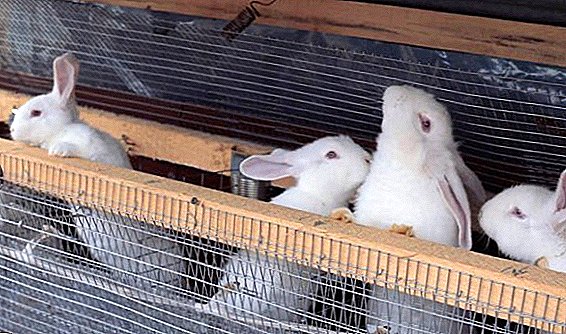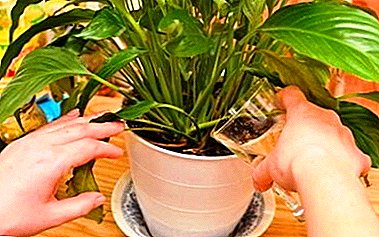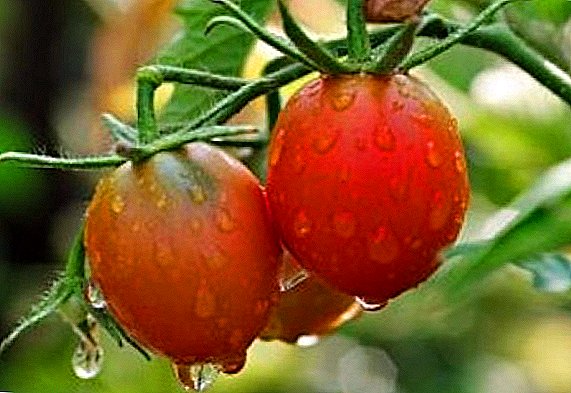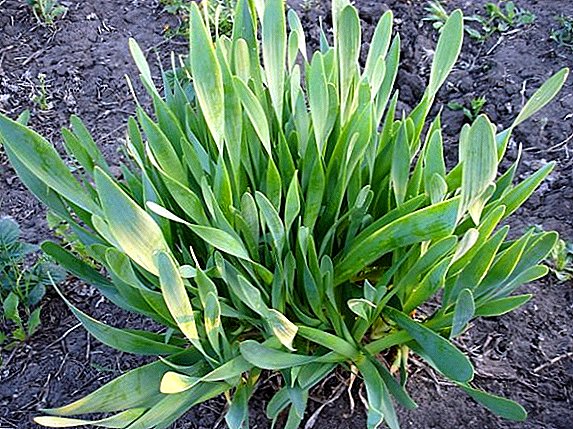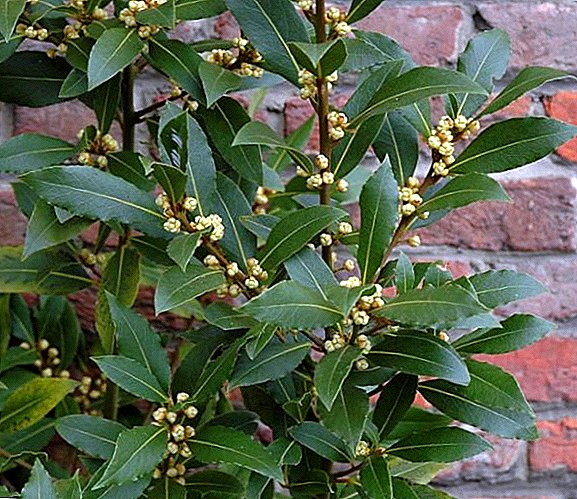 Almost all hostesses are probably familiar with bay leaves, but few of them know that laurel is not only a spice habitual for us, but also a very beautiful tree, often used for decorative purposes. If you carefully study all the features of its growth and development, you will realize that you can successfully grow a plant at home.
Almost all hostesses are probably familiar with bay leaves, but few of them know that laurel is not only a spice habitual for us, but also a very beautiful tree, often used for decorative purposes. If you carefully study all the features of its growth and development, you will realize that you can successfully grow a plant at home.
Dates of sowing laurel
Noble laurel can breed in several ways, but most often practiced growing plants from seed or by grafting. The latter option is preferable, as it takes less time, but many gardeners still practice seed propagation.
 The best time for sowing seeds in room conditions will be the end of winter or the beginning of spring, but if you purchased seed material at another time, it is better not to use it and hide it for a few months in a cool place, before pouring it with sand.
The best time for sowing seeds in room conditions will be the end of winter or the beginning of spring, but if you purchased seed material at another time, it is better not to use it and hide it for a few months in a cool place, before pouring it with sand.
In such conditions, the seeds of bay leaf can be safely stored for 2-3 months, although in this case it will be difficult to guarantee 100% germination.
Did you know? In the wild, a laurel tree can reach 18 meters in height, and the diameter of the trunk often corresponds to 40 cm (it lasts 300-400 years).
Laurel of seeds: how to choose a quality planting material
It is good if you have the opportunity to independently harvest laurel berries or purchase plant seeds from proven people, but in most cases they have to be bought from strangers.
Therefore, it is important not only to know what laurel seeds look like (large, oval, up to 2 cm in length, with a thin and fleshy shell), but also to take into account their shelf life (from the time of packaging), especially when buying purified material, as untreated stored 2-4 times longer peeled.
By themselves, the seeds of laurel and so it is very difficult to germinate, but if you buy copies that are more than one year old, their germination will take twice as long.
Important! The seeds of laurel contain a large amount of essential oils, which are the cause of slow germination of the plant. Beginners in the field of gardening often do not take into account this fact and simply stop caring for crops, later complaining about the failure of their venture.
Climatic conditions for the reproduction of laurel
The noble laurel belongs to subtropical plants, and this means that it is excellent for growing in those climatic zones where temperature indicators do not fall below -12 ... -9.5 ° С. In addition, in some cases, such plants can successfully tolerate short-term frosts and down to -15 ° C.
Nevertheless, one compliance with the climatic zone is not enough to guarantee the well-being of the laurel in the circle of other trees in your garden. The success of the cultivation is also influenced by other features of the territory, which, above all, include soil composition and light.
In nature, the laurel tree survives well both in the sun and in partial shade, as well as in the undergrowth of deciduous forests. However, the full saturation of leaves with essential oils is possible only with good sunlight throughout the spring-summer period.
Only in this case, by the end of November - the beginning of December, you will be able to get the most ripe seasoning for culinary purposes or excellent raw materials for medicinal use.
How to prepare the ground for planting laurel tree
 When breeding laurel seeds can not be ignored and the composition of the soil in which they are sown. You also need to understand that the temperature of the earth should not be below 20 ° C, as in cold soil it will be difficult to achieve high seed germination.
When breeding laurel seeds can not be ignored and the composition of the soil in which they are sown. You also need to understand that the temperature of the earth should not be below 20 ° C, as in cold soil it will be difficult to achieve high seed germination.
A nutrient and loose substrate is ideal for growing laurel, but he does not like acidic soils, which is why experts recommend adding wood ash to the soil.
Before planting seeds directly, the following soil mixture can be prepared: Two parts of leafy ground should be mixed with a similar amount of humus soil and add one part of sod soil, as well as one part of peat and sand.
A good option is considered to be a mixture of equal parts of turf and leaf land, to which 20% of sand is added.
The resulting substrate is scattered in separate pots with a diameter of at least 10 cm and a little ash is added to it.
Did you know? They knew about the beneficial properties of bay leaf a few thousand years ago and successfully applied it in traditional medicine. In addition, the ancient Greeks and Romans attributed magical properties to this plant and believed that a leaf of a tree could bring them good luck.
Seed preparation for planting
Growing noble laurel from seed also provides for some preparatory measures for sowing material.
 For example, the seeds of this plant do not tolerate drying and retain good germination only for 3-5 months, and then when stored in a cool and damp room.
For example, the seeds of this plant do not tolerate drying and retain good germination only for 3-5 months, and then when stored in a cool and damp room.
Before direct planting of seeds into the ground, they should be freed from the shell, otherwise you will have to wait a long time for germination.
It is best to sow the laurel in separate pots with a volume of at least one liter or directly into the open ground (in a permanent place).
Usually the seeds sprout from April to August, but there are cases when they begin to germinate only in January, and then in the presence of strong frosts the seedlings immediately die.
To increase seed germination, you must follow a few simple rules: remove the fruit from the tree in November; keep the seeds moist, but not wet (no more than 2-3 months) until planting, and remove the skin before planting in the ground.
It is possible to accelerate the germination process by pre-soaking the seeds in a weak solution of potassium permanganate for 2-3 days, after which the oily pericarp should be cleaned.
Scheme of sowing laurel
Planting laurel seeds is a relatively simple process. Having prepared the soil in one of the above schemes, you need to put seeds into it at a depth of 1-2 cm and, after fixing them, wet the earthen ball well.
 Then the container with crops is covered with glass or transparent plastic film (it should not touch the ground) and placed in a warm place.
Then the container with crops is covered with glass or transparent plastic film (it should not touch the ground) and placed in a warm place.
When the first shoots of the “cape” appear, they clean and continue to monitor the soil moisture, since even a small drying can significantly slow down the growth of seedlings.
As soon as the plants have the first two leaves, they should be transplanted according to the 2 x 2 scheme in open ground or in separate small pots.
How to care for laurel tree seedlings
As you can see, growing laurel from seeds right at home is not such a difficult task, but the seedlings need proper care both before and after seed germination.
Glass or film, which covered with a container of seeds, must be removed daily for 15-20 minutes. Airing and maintaining constant humidity will not allow the seeds to dry out, and with the appearance of the first sheets in the shelter, there will be no need.
At this time, you should move the plants to a more lighted place (after about 30-40 days).
Once every two or three days, crops are watered with settled water at room temperature, and after the seedlings have 2-5 true leaves, they perform a pick.
Important! The taproot of a laurel seedling is long and fragile, therefore, before transplanting, the plants are watered abundantly (this softens the soil).
Laurel seed: picking seedlings
 As soon as the laurel seeds have sprouted and the first real leaves have appeared on the seedlings, it's time to think about how to plant them correctly in open ground or in a larger container.
As soon as the laurel seeds have sprouted and the first real leaves have appeared on the seedlings, it's time to think about how to plant them correctly in open ground or in a larger container.
As a substrate for seedlings, you can use a mixture of turf land, sand and rotted manure mixed with high-moor peat. Drainage is installed at the bottom of the pot or pot (small coals of deciduous trees can be used), and then the prepared mixture is poured and the plant itself is placed into it.
After transplantation, the earth lump is well watered with separated water, the temperature of which should be 2-3 ° C above room temperature. Thus, you can help better plant survival.
For the next few weeks, avoid direct sunlight on the seedlings, and after the "quarantine" you can safely put the laurel in a well-lit place, which will only contribute to its further successful growth.
As fertilizer laurel use mineral and organic complex fertilizers, which are applied to the soil every month. This procedure becomes especially relevant during the growing season, although it is also not worthwhile for them to overfeed the plants.
 Even under all the conditions of planting and care, the seed laurel grows rather slowly, and it needs to be replanted about once every two years (as soon as the roots fill the pot space completely), but if you reserve patience, your venture will surely succeed and you will grow excellent plant.
Even under all the conditions of planting and care, the seed laurel grows rather slowly, and it needs to be replanted about once every two years (as soon as the roots fill the pot space completely), but if you reserve patience, your venture will surely succeed and you will grow excellent plant.


